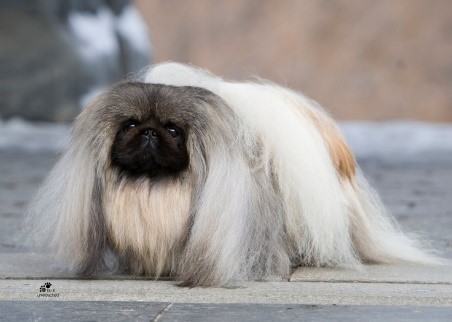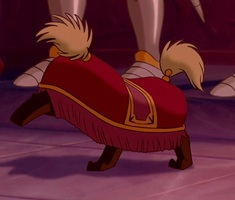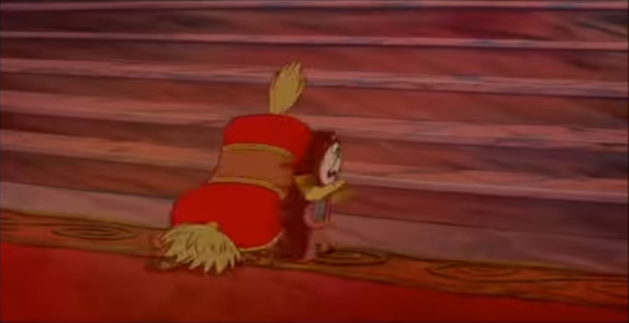Ostensibly, the transformation of a dog into a footstool in Beauty and the Beast operates as a humorous pun.[1] Visually, it works: Sultan in footstool form is around the right size, his tassels stand in for a head and tail and his decorated legs make convincing paws. Furthermore, the transformation of a dog into a footstool plays on the domestication of dogs and the utility that humans derive from them.
Sultan is introduced to the film as a dog. We hear Sultan’s barks before we see him. This creates ironic humour when the audience sees an animated footstool rather than a dog. Sultan darts through the still frame and knocks Cogsworth, causing him to spin. Sultan, therefore, embodies the common perception that animals are erratic and uncontrollable.
A match shot then shows him bound up to Maurice, shake, and jump up to the arm of the chair that Maurice is sat on, demanding to be stroked. When stroked, Sultan’s tail/tassel wags, illustrating his satisfaction with the attention. The film then cuts to a close up of Sultan’s “face” as he makes sympathetic yelps of enjoyment. Maurice greets Sultan with: ‘Hello there, boy’. This assumption of gender again fits traditional representations of dogs in film. In this scene, Maurice is the first human that Sultan has seen in years and his reaction shows that he desperately craves human affection.
Therefore, when Sultan is introduced to the film, the fact that he has been magically transfigured into a footstool does not matter. Whereas other characters in the film understand and are actively seeking resolution to their transformation, Sultan has no perceivable understanding of the enchantment. Instead, Sultan is able to be happy and fully his former self in his footstool form. The use of animation allows the film to codify the piece of furniture as wholly animal.
So far, so dog. However, after this exchange Sultan shakes off Maurice’s hand, jumps down from the armchair and runs under Maurice’s feet. Sultan’s legs straighten and he freezes into a fully footstool form. The ceasing of animation of Sultan illustrates how his character operates in a binary, he is either footstool or dog. This is a marked difference from other characters in the film who exist in a liminalspace. The other characters have become anthropomorphised objects, they are at once their former human selves and the object that they have become.
Although Sultan has been subject to the same transformation as the other characters in the film, the fact that he is animal rather than human means that different rules apply to him. The other character’s awareness of their situation has meant that they still see each other as human. However, through the singling out of Maurice and wanting to be stroked by him, we are made aware that Sultan no longer sees the other characters as human. In addition, Sultan’s operation within the animal/object binary establishes the idea that the animal is not complex enough to incorporate two modes of being at once, signalling the superiority of the human in the film.
In relation to the main plot of the film we can see the same ideas being recreated. The beast’s character arc is reliant on him shaking off his animal qualities and learning how to be cultured, the idea of culture being something that is privileged as exclusively human.
[1] Beauty and the Beast. Dir. Gary Trousdale & Kirk Wise. Buena Vista Pictures. 2001.



